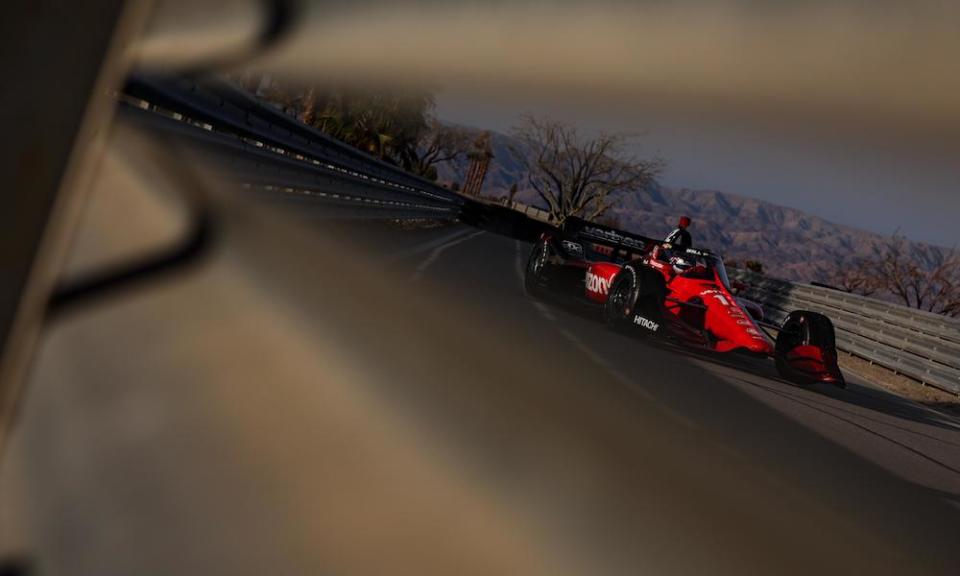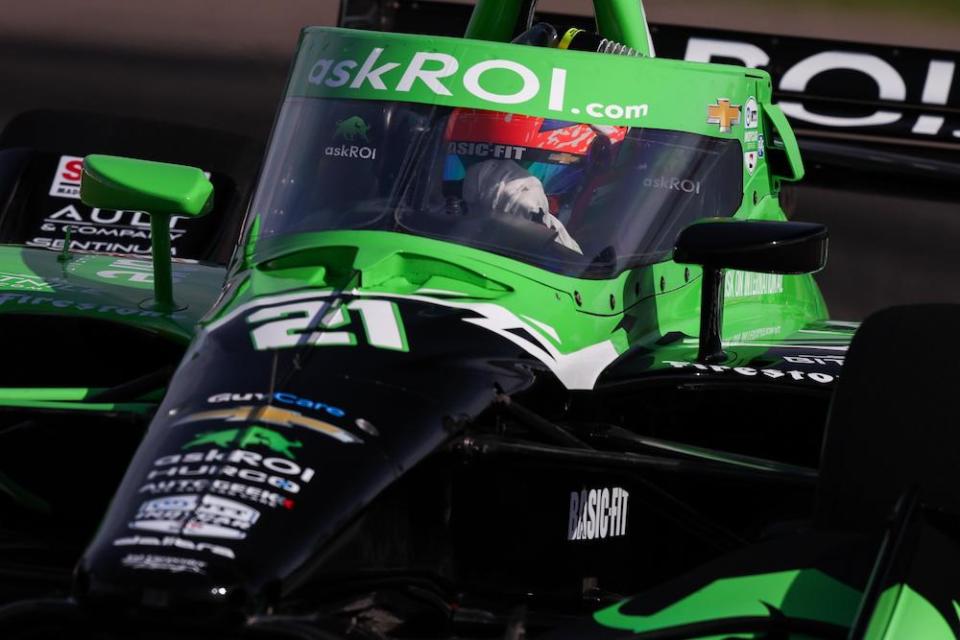The IndyCar field prepares to race for everything – or nothing – at Thermal

Sunday’s $1 Million Challenge all-star race at The Thermal Club is expected to go one of two ways: Pure boredom or pure mayhem.
Constructed in a heat-based format that’s not too dissimilar from IndyCar’s knockout qualifying system, two 10-lap heats will be held Sunday morning, with 13 cars in one and 14 in the others, and from both heats, the top six finishers will advance to the 20-lap grand finale.
Those 12 will race for 10 laps, pit for a 10-minute halftime during which their cars will be refueled and have setup changes made, and then they’ll do the last 10 laps to determine the finishing order and who gets the biggest payouts. As relatively simple as that sounds, there are significant questions as to how it will play out at the private road course located in the southern California desert.
Will we look back at IndyCar’s gap-filling event, which was created to bridge the six-week span between St. Petersburg and Long Beach, as a processional affair where the 12 drivers keep it clean at the non-championship race, or will it be a stampede — the Paul Tracy Chrome Horn Memorial — as those dozen drivers chase the $500,000 on offer to win?
“Maybe if it was $20 million bucks,” six-time IndyCar champion Scott Dixon told RACER. “Of course the money means something, but then you’ve also got to sum up if it’s worth damaging the car for a couple hundred grand and maybe finishing last. Do you want to risk damaging the motor and then get an engine penalty at a real race?
“Honestly, I think the format could have been a little better. It’s 10 laps, you do a halftime because we can’t to the whole distance [on a single tank of fuel], and then it’s 10 more laps? Why not just do a pit stop after 10 laps and skip the halftime? If we had a tire with really high [degradation], I could maybe see it’s working, but you’re not going to get that in 10 laps, so I don’t know. I still think it’s cool to explore these ideas, and hopefully it takes off and it’s hugely successful.”
With a lifetime of earnings that push well into the eight-figure mark, Thermal’s prize money isn’t going to change Dixon’s life, but for a driver in the early stages of their career, the cash bounty can be a serious motivator.
“I cannot recall ever racing for a purse,” said 23-year-old Rinus VeeKay from Ed Carpenter Racing. “Usually winning is the motivation, and money goes with it. If you do well, the financial aspect sorts itself. Every race win counts, just in a different way. So I think it’s going to be fun; there’s always some money involved if you win, of course, but no points here. It’s a different mindset.
“I think people are willing to take more risks. It’s basically an all or nothing kind of race. I’m curious to see how it will go. But it’s really good that they paired it with a two-day test so that everybody would show up.”
The Friday-Saturday open test will give teams a chance to refine their Thermal-specific setups ahead of Saturday evening’s qualifying session, when the field will be split into two 12-minute sessions and the starting order for Sunday morning’s twin heat races will be determined.

Prize money but no points means a different mindset at Thermal, according to Rinus VeeKay. Chris Owens/IMS Photo
A quick driver like VeeKay has a solid chance to be part of the final 12 who race for the prize money, and from the Dutchman’s perspective, there’s a perfect spot to be in the final laps of the contest where contact is expected to take place.
“I actually think the best strategy for the all-star race is being P3 and just waiting for top two guys take themselves out,” he said.
For two-time IndyCar champion Will Power from Team Penske, the pursuit of his third title will — like Dixon — take precedent over bashing his way to victory lane.
“It’s honestly a little less stress because you’re not racing for points,” he said. “You’d much rather get points and money. I don’t want to hurt my engine. I don’t want to do anything that’s going to jeopardize the championship. If other drivers want to get wild, that’s on them. I mean, the money is nice, but the mindset is whoever comes out of the first corner in first place is going to win because we can use push-to-pass to defend overtakes.
“In the winter meetings, I said to IndyCar ‘you should try a no-reply push-to-pass at this race so the leader can’t negate it by using their own push-to-pass’, but I guess [IndyCar] must not have been able to do it. But in the race, my mind says I don’t want to damage anything. I’m thinking of this as a test. A cool open test with money at the end.”
And for those who are wondering why the ‘math isn’t mathing’ on the $1 Million Challenge that pays half of that amount to win, The Thermal Club removed the component that would have paid half of the prize money to a club member who was originally attached to each entry.
With those plans shelved, the total payout has been halved, but the revised financial structure is unchanged for the teams and offers $500,000 to the winner, $350,000 to second, $250,000 to third, $100,000 to fourth, $50,000 to fifth, and the rest get $23,000 apiece.
The change, in terms of accuracy, means Sunday’s non-points event is now the $500,000 Challenge, but having been announced as the $1 Million Challenge, the circuit opted to keep the original name for the sake of consistency.
The series also boasted that the $1.756 million purse is the “Largest in IndyCar Series history outside of Indy 500,” which RACER has learned is an unintentional oversight.
That honor belongs to the 1996 U.S. 500 held at Michigan Speedway, which was the CART IndyCar Series’ answer to the Indy Racing League’s Indy 500.
As former CART CEO Andrew Craig shared in a reminder email over the weekend, the purse for the inaugural U.S. 500 was $3.5 million, making The Thermal Club’s payout, at most, the second largest outside of the Indy 500.

 Yahoo Autos
Yahoo Autos 